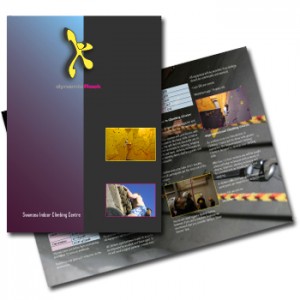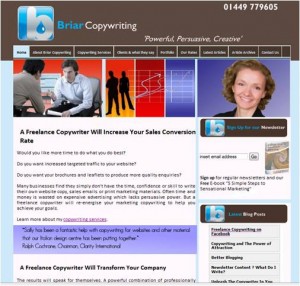Entries Tagged 'briefing a copywriter' ↓
October 12th, 2011 — briefing a copywriter, copywriter, copywriting, researching your customers, Writer
 Ever wondered how a copywriter does it?
Ever wondered how a copywriter does it?
Day after day, they sit in front of their computers writing amazing copy that compels even the most hardened cynic into buying products and services they didn’t realise they needed.
They must be truly inspiring individuals, creative geniuses, magical wordsmiths…or they could just be great researchers.
That’s burst the bubble, hasn’t it?
True, they are great writers, but their constant stream of inspiration doesn’t float down from the ether to them. They have to work at their art and that means researching.
Research, a copywriters’ best friend
Contrary to popular belief, when you send a brief to a copywriter, the first she doesn’t do is write.
Before any creativity can occur, your copywriter has to do some leg-work – i.e. research – and lots of it.
If you were commissioned to create a wedding cake, you wouldn’t just grab the deposit and start baking. No, you would sit down with your client and ask questions so you fully understood what they wanted, what their colour scheme was, whether they wanted plain sponge, chocolate or fruit cake…
In the same way, your copywriter has to research:
- You – to discover precisely what you want to achieve
- Your company – so they understand your ethos, brand and voice
- Your customers – after all, if they don’t know who they are writing to, how will they know what to say?
- Your product/service – they have to understand every aspect of it to discover its main benefits
- Your competition – they need to know what else is out there and what makes your product/service different
Only once they have done all that, can they sit down and start to craft their copy.
You see, creativity doesn’t come from thin air. It must have substance and be based on you, your company and, more importantly, your customers. Only once your copywriter has discovered who your audience is and what will make them buy, can they begin to write compelling and persuasive copy.
Guess work
What happens if they just guess?
Well, the copy won’t reflect your values or brand image. The benefits of your product or service won’t come across, so your customers won’t buy.
That’s why the research element of any copywriting project is so important.
The moral of this post is, if you want your copy to resonate with your customers and make them buy, you must allow your copywriter sufficient time to research your market fully.
July 1st, 2011 — briefing a copywriter, brochure copy, brochure copywriting
 Doesn’t it look great?
Doesn’t it look great?
It took months to put it together but there it is in all its glory. Your new, shiny, gorgeous corporate brochure is ready to be distributed.
Are you pleased with it?
Hmm…if you’re that pleased there may be a problem – let me tell you why.
Giving in to temptation
Everyone does it now and then but temptation has its place and there is no room for it in your brochure.
Often, when you start to think about the content for your corporate brochure you:
- Talk about you
- You give your opinions on you
- You talk about what you want to achieve
Boring.
Don’t get me wrong. What you do is incredibly valuable but people (i.e. Joe Public) aren’t interested in what you think about your self, they are interested in themselves.
Doing it right
With the economy being what it is at the moment, the fact that you’re investing in a glossy, expensive corporate brochure tells the market (and all your competitors) that you’re doing well; you have a motivated and engaged team who are working their butts off to make you look great.
Fantastic – by why do all of this?
Well, a good brochure will help you:
- Gain investor confidence
- Attract new clients
- Show existing clients what you can do for them
- Impress the great and the good
But the problem is that there aren’t that many companies out there who do it right.
There’s no escaping the fact that you need a large team to pull off a cracking end result – designers, photographers, a great brochure copywriter. These guys are all experienced in what they do and can easily collaborate to achieve the ultimate end result.
However the main problem lies within your company. Although one person is assigned the headache of pulling the expert team together, the review stage is usually done by many people (CEOs, Directors etc.) which means there are too many opinions flying around the room.
Your brochure should not contain any corporate speak – in fact your expert copywriter would have gone to great pains to ensure the language is simple, accessible to all, clear and powerful which is not an easy thing to pull off. And yet by the time the copy has gone round everyone it’s mutated into an overly intellectual hotchpotch of meaningless drivel.
The design has been mauled mutating the understated, tasteful design into something way too ostentatious. And the wonderful photography of your staff and company has been replaced by dodgy stock images.
Why?
If you call in a group of experts to create your corporate brochure let them get on with it – they know what they are doing.
The perfect formula
Your corporate brochure has to be something people will want to pick up and read. If they don’t it becomes an extremely expensive coaster.
Use it wisely and make sure yours includes:
- A personal letter written by your Chairman or CEO
- Photos of your staff (be proud of them and show them off)
- Testimonials from customers
- Engaging case studies to show how you have helped clients overcome typical challenges
- A profile of your organisation
- Benefits driven copy to show how you can help your customers
- High level product descriptions and images
- Full and correct contact details
To make sure yours is done right make sure you start the process of with a plan. Decide amongst yourselves what you want to achieve, how you want it to look and how you want it to sound.
Then provide your expert team with a detailed brief for each element – design, photography and copywriting.
After that, sit back and let them get on with it.
Setting out your vision at the outset will ensure your get the result you were looking for.
Time to have your say
I’ve spouted on long enough, now I want to hear from you.
What, in your opinion, makes a good brochure?
April 6th, 2011 — briefing a copywriter, copywriter, copywriting tips, Copywriting tone, freelance copywriter
 Something strange happens to people when they try to communicate through writing. Their normal chatty engaging style goes out the window for something more akin to a literary novel.
Something strange happens to people when they try to communicate through writing. Their normal chatty engaging style goes out the window for something more akin to a literary novel.
Why?
You’re still talking to the same people (your customers), it’s just through the written word rather than voice.
Getting the tone and voice of your copy right can make a huge difference to customer engagement and your conversion rates. Your copywriter will be able to adapt their writing style to any ‘voice’ you want, but you might have to give them a few clues.
What do you really want?
Your copywriter is an expert at what they do, however that doesn’t make them a mind reader.
When you brief them make sure you give them a real taste of what you’re after with regards to the voice and tone you want the copy to convey.
Saying something like – “I want quirky”, or “I want something fresh” doesn’t really help. Granted they realise the type of approach you’re after but quirky and fresh could cover numerous styles.
It is very likely you’ve done your research and come across another website or brochure etc., that uses the style you’re after. If so, cite them as examples to your copywriter so they can read the material and get a real feel for what you are trying to achieve.
The copywriting process is a very collaborative one. You can’t just hand over a brief and expect copy that is spot on first time (OK, that’s not strictly true, that does happen sometimes – and it’s great when it does – but frequently it’s not until you actually see the copy that you begin to work out what it is you really want).
The first draft is the copywriter’s visualisation of what the brief you provided asked them for. Once you see the copy it is then shaped into exactly what you want.
By giving a visual example of the tone/voice you want will help the creation process enormously so please make sure you provide examples wherever possible.
November 15th, 2010 — briefing a copywriter, copywriter, copywriting, copywriting services, freelance copywriter

As a freelance copywriter I receive numerous requests for quotes every week.
They can be anything from new website copywriting, content for a brochure or direct mail letters to newsletters, email marketing and case studies. To make sure I get all the information I need I use a pro-forma that asks a series of questions designed to extract as much information as possible from the client so I can put together a comprehensive proposal and quote.
Most of the time clients are more than happy to complete the form in a very detailed way. However, every so often, clients will just jot down the bare bones of what they’re looking for assuming I’ll be able to fill in the blanks.
I’m good, but I’m not that good.
What your copywriter needs to know
When I first started as a freelance copywriter, one friend said to me “But why would I need a copywriter? You couldn’t possible know my business better than I do” and he was right, I couldn’t – not only that, I would never suggest I did. But that’s not what copywriting is about.
It’s not about who knows your business the best, it’s about who can write the strongest sales message.
Business owners tend to want to write about their business and achievements. They find it difficult to stand back and see their company from their customers’ point of view. And that’s were a professional copywriter comes into their own. Not only do they understand how to write powerful marketing copy, they can also view the company and its products/services from the customers’ perspective.
But to be able to do that, your writer is going to need as much information as possible about your company, its services and products, its ethos as well as the tone you want to convey.
Can’t you just write it?
As I mentioned earlier most of my clients appreciate what they need to provide me with, but there’s always the odd one that doesn’t. They think they’re doing my job for me by providing me with information – well, I don’t have a crystal ball, I don’t know your company intimately so I can’t write fabulous copy just from you company name.
To illustrate my point consider what would happen if you wanted someone to build you a house. When you sit down with your builder to brief him and say – “I want you to build me a house. Get on with it.”
Is he going to say “OK” and start building? Very unlikely.
He’ll want to know:
- What style you want – detached, semi, bungalow
- How many bedrooms
- How big the rooms should be
- How many rooms you want
- How big is it going to be
And that’s just for starters.
You wouldn’t dream of doing this so why expect your copywriter to write amazing SEO website copy from your instruction “I want you to write my website – get on with it”.
The copywriter/client relationship is a very close one. You have to work together to achieve the right copy. It’s a very collaborative approach and one that can create a strong working relationship. The more work your copywriter does for you, the better they get to know your company. They will be able to make suggestions and point out areas of your marketing that need strengthening, giving your income a much needed boost.
A great copywriter is a valuable asset for any company to have and a worthwhile investment. Through their marketing expertise your company will gain the upper hand. Through powerful brochures and email campaigns to strong SEO website copy to boost your rankings, your copywriter is quite literally worth their weight in gold.
 Ever wondered how a copywriter does it?
Ever wondered how a copywriter does it? Doesn’t it look great?
Doesn’t it look great? Something strange happens to people when they try to communicate through writing. Their normal chatty engaging style goes out the window for something more akin to a literary novel.
Something strange happens to people when they try to communicate through writing. Their normal chatty engaging style goes out the window for something more akin to a literary novel.





